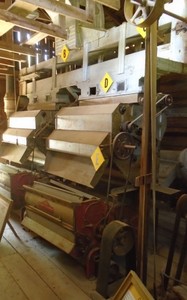Munger Ginning System
Introduction
Text-to-speech Audio
The invention of the cotton gin revolutionized the cotton industry by making tremendous amounts of cotton fiber available to the world. Much of that fiber came from gins such as this one. Goodlett kept pace with the demand by constantly improving his equipment. Though his original hand-fed gins no longer exist, the equipment you see today represents the growth and changes of 80 years.
Images
Munger gins inside Goodlett Cotton Gin

Backstory and Context
Text-to-speech Audio
In 1898 Goodlett installed his first boiler and steam engine which ran two 60-saw gins and a Continental drop press. A wooden Continental distributor and lint flue plus a drag-type, wooden box conveyor distributor were added by 1911. During the 1930s, two 70-saw gin stands and two rebuilt feeders were installed, and the boiler replaced. The system seen here was designed by the Munger Company of Texas and is known as a Continental Munger Plant.
After the cotton was weighed in the Scale House, it was literally sucked up into the ginning system by a suction pipe using air generated by a fan (A). Before being fed into the saws, it was put through an extractor-cleaner (or vacuum dropper) which broke it up and aided in drying the bolls (B). The conveyor distributor (C) carried the cotton to the feeders (D) which spread the cotton bolls evenly over the width of the gin stand. The large 70-saw gin stands (E), consisting of a series of circular saws with fine teeth, revolved causing the lint or fiber to separate from the seed. The seeds dropped to a conveyor belt; starting in the 1930s, they were carried to the seed cleaner (F) where they were sterilized with heat to protect against pink bollworms. The seeds were then dropped into the original conveyor that carried them to the Seed House for storage.
The clean cotton fibers were lifted by an air stream at the back of each stand through a large flue (G) to the condenser (H) which formed the cotton into batts or layers. Gravity fed the batting into the press boxes.
Sources
Brooke, Steven. Historic Washington, Arkansas. Gretna, Louisiana. Pelican Publishing Company, 2000.
Medearis, Mary. Washington, Arkansas : History on the Southwest Trail. Hope, Arkansas. Copies + Office Solutions, 1984.
Williams, Charlean Moss. The Old Town Speaks : Washington, Hempstead County, Arkansas, gateway to Texas, 1835, Confederate Capital, 1863. Houston, Texas. The Anson Jones Press, 1951.
Williams, Joshua. Washington. Images of America. Charleston, South Carolina. Arcadia Publishing, 2014.
Historic Washington State Park Collection
